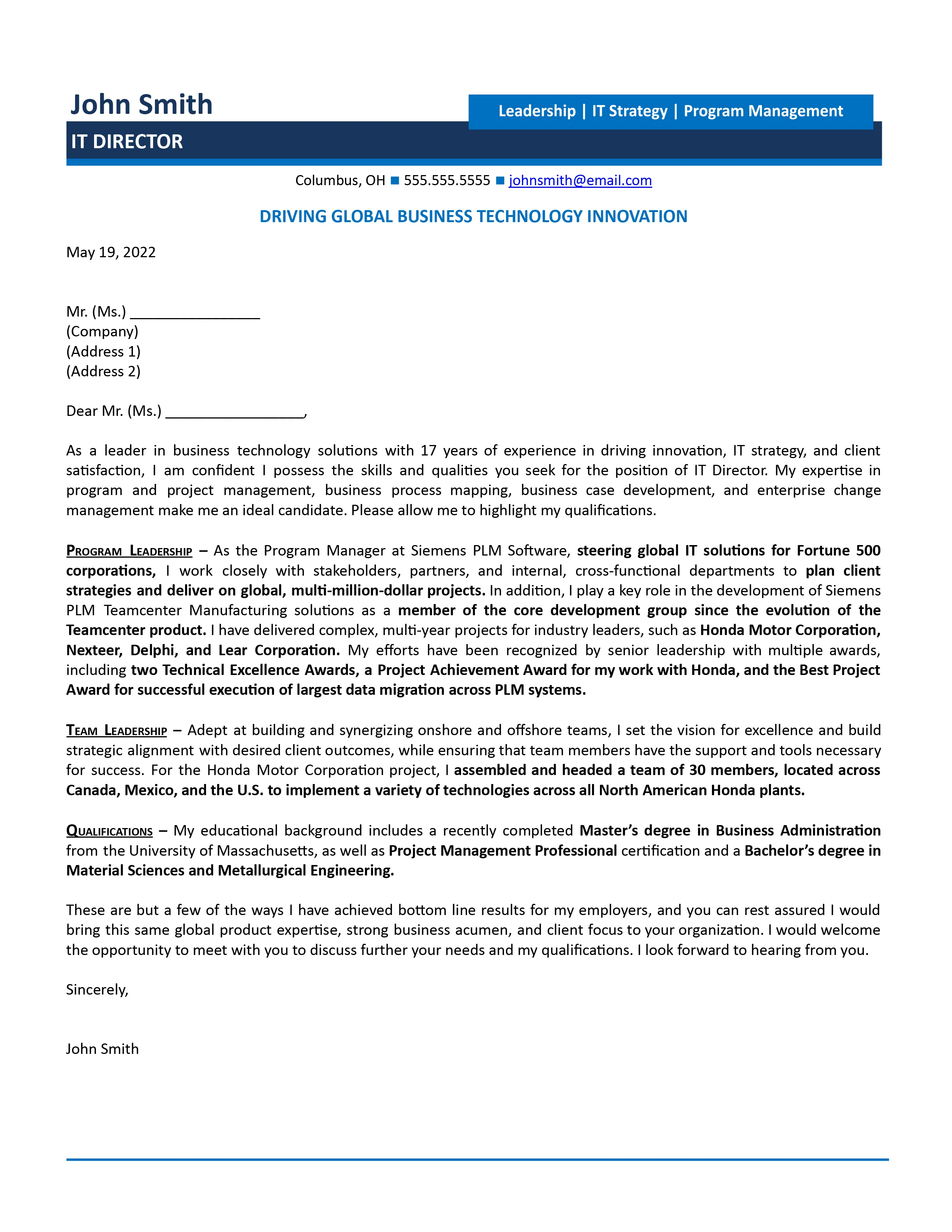Understanding the Director of IT Cover Letter
A Director of IT cover letter is a critical document that introduces you to a potential employer and highlights your qualifications for the role. It’s your opportunity to make a strong first impression and demonstrate why you are the ideal candidate. Unlike a resume, which provides a comprehensive overview of your experience, a cover letter allows you to tell a story, connecting your skills and accomplishments to the specific requirements of the job. It’s a chance to showcase your personality, communication skills, and enthusiasm for the position. A well-crafted cover letter can significantly increase your chances of landing an interview and ultimately securing the job.
Key Components of a Director of IT Cover Letter
A compelling Director of IT cover letter comprises several key elements that work together to present a complete picture of your suitability for the role. These components include your contact information, the hiring manager’s details, a strong opening paragraph, a detailed presentation of your skills and accomplishments, and a professional closing. Each section serves a specific purpose, and when combined, they create a persuasive argument for why you should be considered for the position. Understanding these components and how to effectively incorporate them is crucial to writing a cover letter that stands out.
Your Contact Information & Date
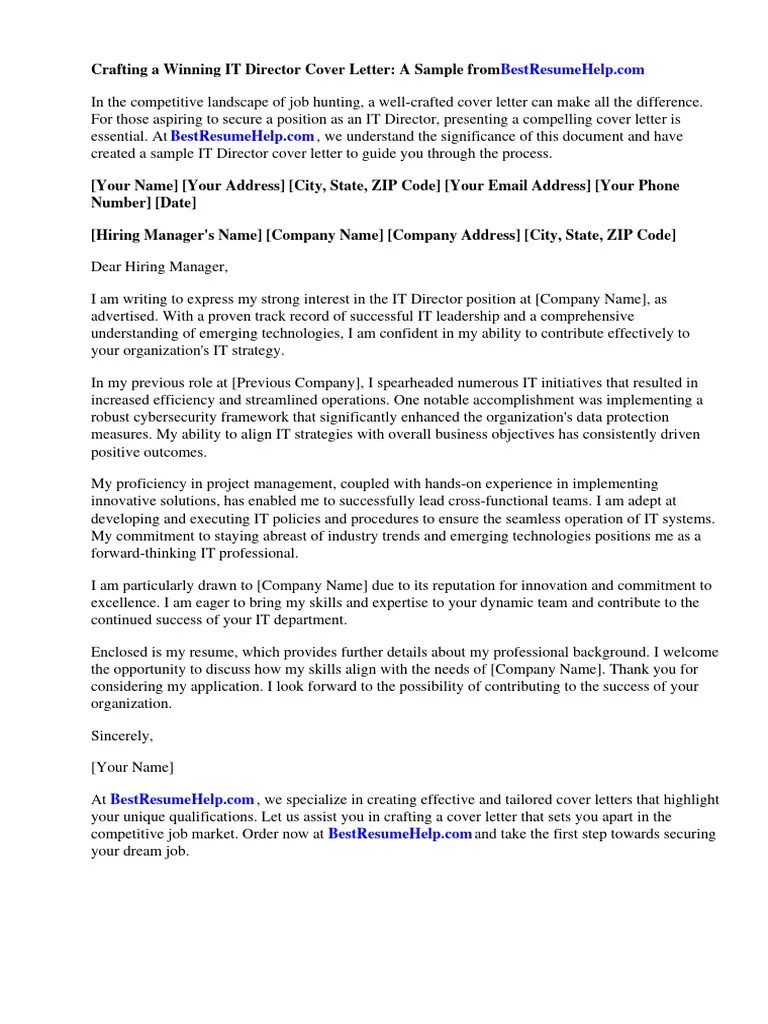
Begin your cover letter with your full name, address, phone number, and email address. Place this information at the top of the document, typically aligned to the left or right. Immediately following your contact information, include the date of the letter. This ensures the employer can easily reach you and know when the letter was written. Accuracy and professionalism are key here – double-check all details for correctness.
The Hiring Manager’s Information
If possible, address your cover letter to a specific person, ideally the hiring manager or the person listed as the contact for the position. Find their name and title by researching the company’s website, LinkedIn, or the job posting itself. If you can’t find a specific name, use a professional salutation like ‘Dear Hiring Manager’. Include the hiring manager’s title and company name to show you’ve taken the time to find the right person. This personal touch demonstrates your attention to detail and initiative.
A Compelling Opening Paragraph
Your opening paragraph should immediately grab the reader’s attention and make them want to read more. Start by stating the position you’re applying for and where you found the job posting. Then, briefly highlight your most relevant qualifications and express your enthusiasm for the role and the company. Show your understanding of the company and the IT industry, demonstrating how your values align with theirs. Make it clear from the outset why you’re a strong fit for the position.
Highlighting Your IT Director Skills
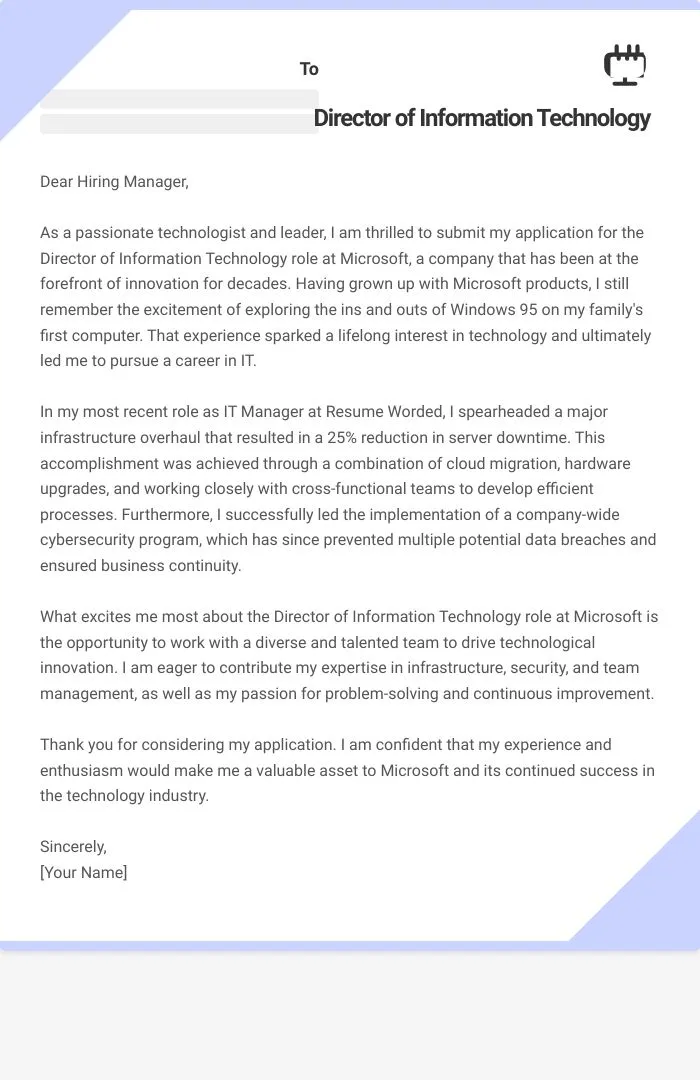
The main body of your cover letter is where you showcase your skills and experience. Focus on the key requirements outlined in the job description and provide specific examples of how you’ve demonstrated those skills in previous roles. Use strong action verbs to describe your accomplishments and quantify your achievements whenever possible. Highlight how you’ve improved efficiency, reduced costs, or driven innovation in your previous positions. This section should be tailored to the specific job and company, emphasizing the skills and experiences that are most relevant.
Technical Expertise
As an IT Director, a strong technical foundation is essential. Highlight your expertise in relevant technologies, such as networking, cybersecurity, cloud computing, data management, and IT infrastructure. Describe your experience with specific software, hardware, and systems. Provide concrete examples of your technical skills in action, such as leading the implementation of a new system, managing a network upgrade, or resolving critical technical issues. This demonstrates your ability to understand and manage the technical aspects of the role.
Leadership and Management Skills
Leadership and management are crucial for an IT Director. Detail your experience in leading and motivating IT teams, managing budgets, and overseeing projects. Provide examples of how you’ve fostered a positive and productive work environment, mentored team members, and resolved conflicts. Highlight your ability to make strategic decisions, delegate tasks effectively, and drive team performance. Show how you can build and maintain strong relationships with both technical and non-technical staff.
Strategic Planning and Vision
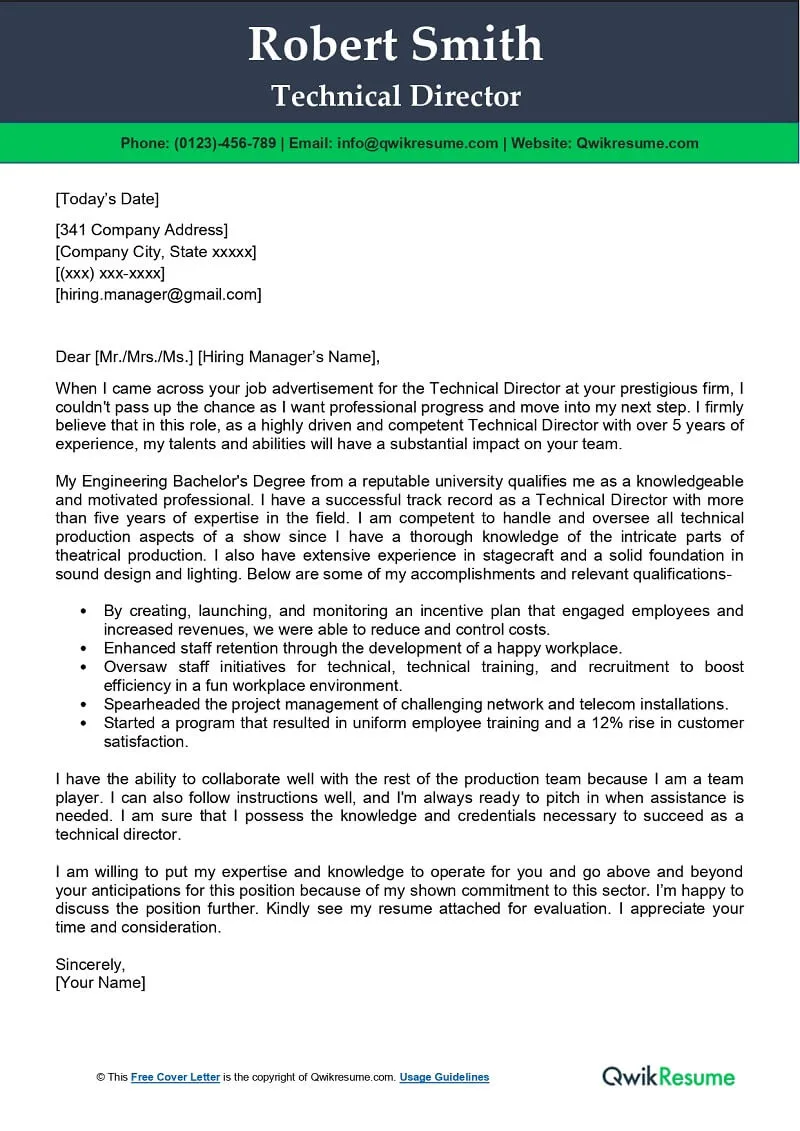
IT Directors are responsible for strategic planning and vision. Showcase your ability to develop and implement IT strategies that align with the company’s overall goals. Describe your experience in assessing IT needs, identifying opportunities for improvement, and creating long-term IT roadmaps. Highlight your ability to stay ahead of industry trends, anticipate future challenges, and proactively develop solutions. Demonstrate your understanding of the broader business context and how IT can support and drive business success.
Quantifying Your Achievements
Instead of simply listing your responsibilities, quantify your achievements whenever possible. Use numbers and data to demonstrate the impact you’ve made in previous roles. For example, instead of saying you ‘improved network performance,’ state that you ‘increased network speed by 30% and reduced downtime by 20%.’ Provide specific metrics like budget management, cost savings, project completion rates, or team performance improvements. Quantifying your achievements provides concrete evidence of your capabilities and makes your cover letter more persuasive. This is a very important aspect of writing a good Director of IT cover letter.
Showcasing Your Impact
Focus on the impact you’ve made in previous roles. Describe the positive outcomes of your actions and the benefits your employers or clients have realized. For example, if you led a successful cybersecurity implementation, detail how it protected the company from data breaches and saved money. If you streamlined an IT process, explain how it increased productivity and efficiency. Use examples of how you have helped increase revenue, reduce costs, or improve customer satisfaction. This demonstrates your value and ability to deliver results.
Using Action Verbs
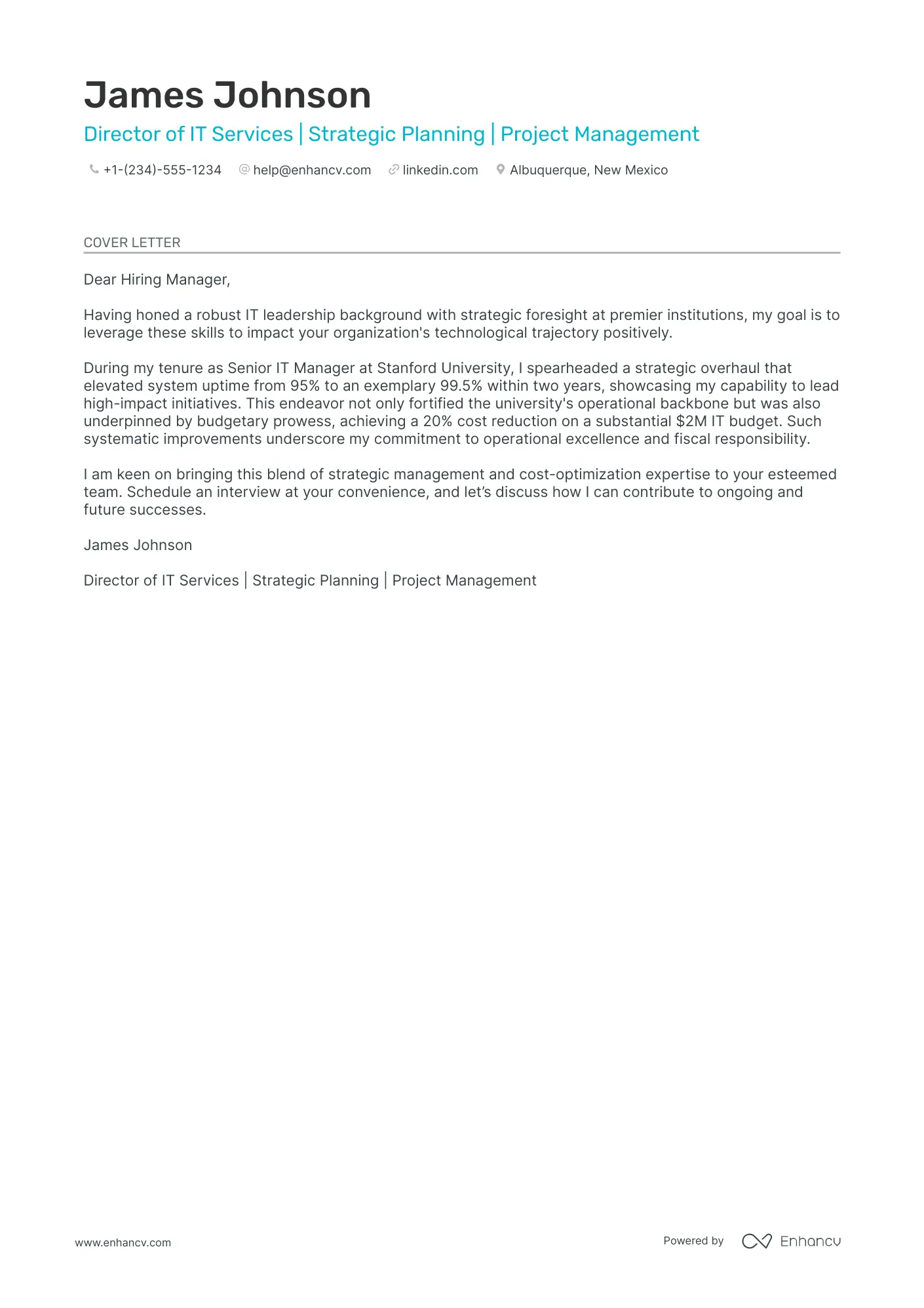
Use strong action verbs to describe your accomplishments and responsibilities. Action verbs bring your experiences to life and make your cover letter more engaging. Examples include: managed, led, implemented, developed, optimized, streamlined, improved, resolved, and achieved. Starting sentences with action verbs emphasizes your contributions and makes your qualifications more compelling. This practice makes your cover letter more active and dynamic, making it more readable.
Tailoring Your Cover Letter to the Job
Each cover letter should be tailored to the specific job you’re applying for. Carefully review the job description and identify the key requirements and desired qualifications. Customize your cover letter to highlight the skills and experiences that align with those requirements. Don’t send a generic cover letter – take the time to research the company and understand its needs. This demonstrates your genuine interest in the role and increases your chances of getting noticed. Showing the time and effort spent shows your professionalism.
Researching the Company
Before writing your cover letter, research the company to understand its mission, values, and current projects. Visit the company’s website, read news articles, and check its social media profiles. This knowledge will help you tailor your cover letter to the company’s specific needs and demonstrate your interest in the organization. Use this information to show how your skills and experience align with their goals. The hiring manager will notice your effort and appreciate your diligence.
Matching Skills to Requirements
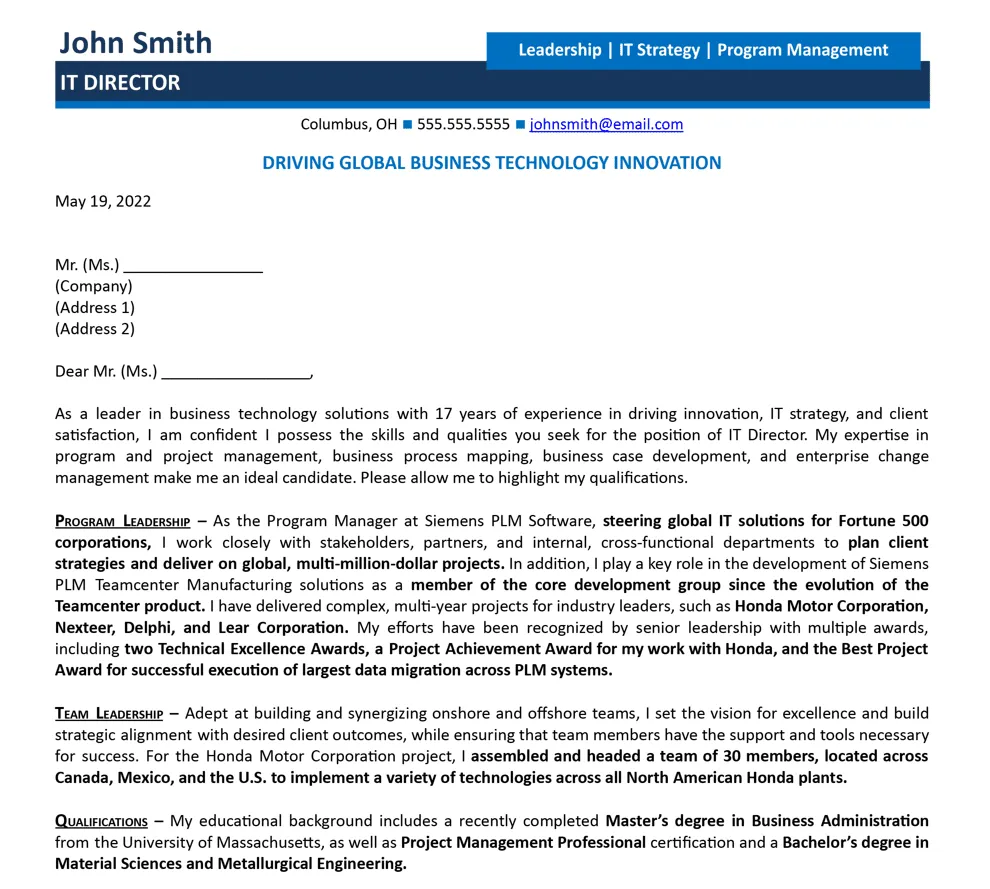
Carefully review the job description and identify the key skills and qualifications the employer is seeking. In your cover letter, explicitly state how your skills and experiences match those requirements. Provide specific examples to support your claims and demonstrate how you’ve successfully used those skills in previous roles. Ensure your cover letter directly addresses the requirements listed in the job description and provides compelling evidence of your abilities. Use the job description like a checklist, and cover each point.
Formatting and Presentation
Formatting and presentation are essential for making your cover letter easy to read and visually appealing. Use a professional font, such as Times New Roman or Arial, and maintain consistent formatting throughout the document. Use clear headings, bullet points, and white space to break up large blocks of text and improve readability. Keep your cover letter to one page, unless the job description specifically requests otherwise. A well-formatted cover letter makes a positive impression and demonstrates your attention to detail. Ensure that you use the right amount of white space to avoid overcrowding the page.
Proofreading and Editing
Proofreading and editing are crucial steps in the cover letter writing process. Errors in grammar, spelling, or punctuation can damage your credibility and undermine your chances of getting an interview. Before submitting your cover letter, carefully proofread it multiple times to catch any mistakes. Consider having a friend, colleague, or career counselor review your cover letter for feedback and suggestions. A polished, error-free cover letter demonstrates your professionalism and attention to detail.
Common Mistakes to Avoid
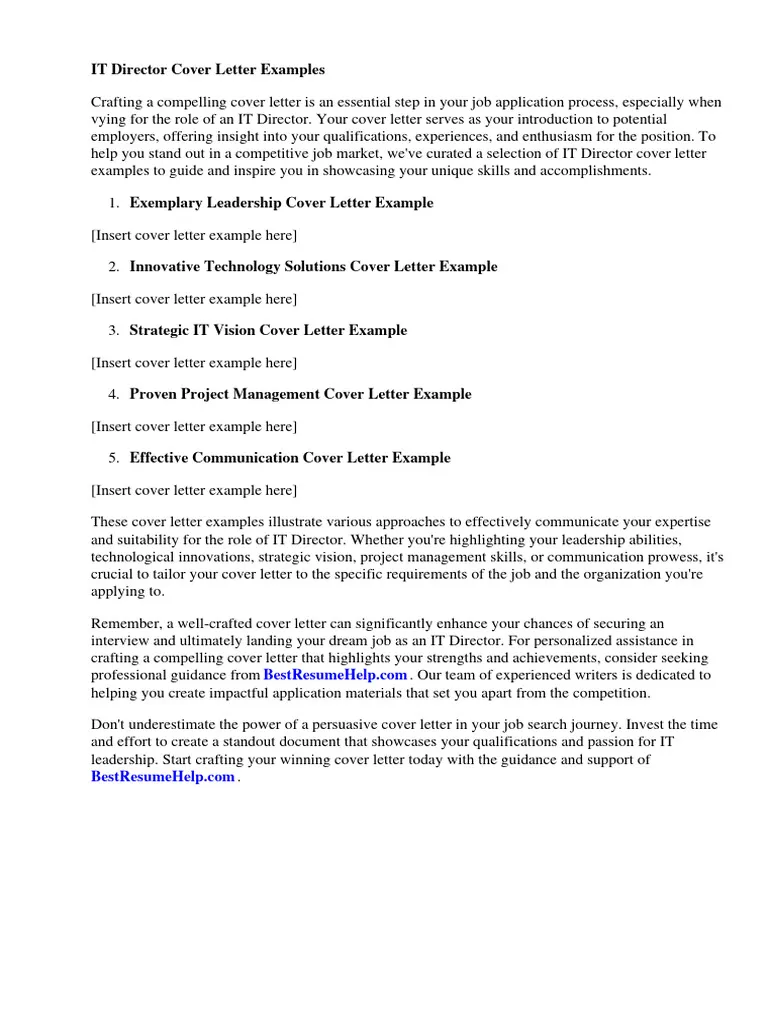
Avoid common mistakes that can weaken your cover letter and hurt your chances of getting hired. Some common errors include generic cover letters, focusing too much on yourself, and ignoring the job description. By avoiding these pitfalls, you can create a cover letter that effectively showcases your qualifications and makes a strong impression on the hiring manager.
Generic Cover Letters
Sending a generic cover letter is a major mistake. Tailor each cover letter to the specific job and company. Generic cover letters do not show that you’ve done your homework. They don’t highlight the value you bring to that specific role. Customize your cover letter to demonstrate your interest in the company and highlight how your skills and experience align with their needs. Generic letters make it seem like you are sending the same application everywhere.
Focusing on Yourself Too Much
While it’s important to highlight your skills and accomplishments, avoid focusing too much on yourself. Instead, emphasize how you can benefit the company and contribute to its success. Frame your skills and experiences in terms of how they can solve the company’s problems or help them achieve their goals. This demonstrates your understanding of the company’s needs and shows that you are a valuable asset. Your cover letter should focus on the value you bring to the table, rather than solely on your own achievements.
Ignoring the Job Description
Ignoring the job description is a missed opportunity. The job description outlines the key requirements and desired qualifications for the position. In your cover letter, specifically address these requirements and provide examples of how you meet them. Highlight the skills and experiences that align with the job description and show how you can contribute to the company’s success. Failing to address the job description shows you haven’t spent enough time understanding what the employer wants.
The Closing Paragraph
Your closing paragraph is your final opportunity to leave a positive impression. Express your enthusiasm for the position and the company. Thank the hiring manager for their time and consideration. Clearly state your interest in an interview and provide your contact information again. Make it easy for the hiring manager to take the next step and invite you for an interview. The closing paragraph reinforces your interest and strengthens your application.
Expressing Enthusiasm and Gratitude
End your cover letter by expressing your enthusiasm for the role and the company. Reiterate why you’re a good fit and what you hope to achieve if hired. Thank the hiring manager for their time and consideration, showing that you value their attention. A sincere expression of enthusiasm and gratitude leaves a positive final impression.
Call to Action
Include a clear call to action in your closing paragraph. Indicate your interest in an interview and express your availability. Make it easy for the hiring manager to contact you by providing your phone number and email address again. A clear call to action encourages the hiring manager to take the next step and move your application forward.
Review and Submission
Before submitting your cover letter, review it thoroughly. Proofread for any errors in grammar, spelling, or punctuation. Ensure that your cover letter is tailored to the specific job and company. Check that you’ve included all the necessary information, and that you’ve formatted the document professionally. Once you’re confident that your cover letter is polished and error-free, submit it along with your resume and any other required documents. Following these steps significantly improves your chances of success and make a lasting positive impression.
